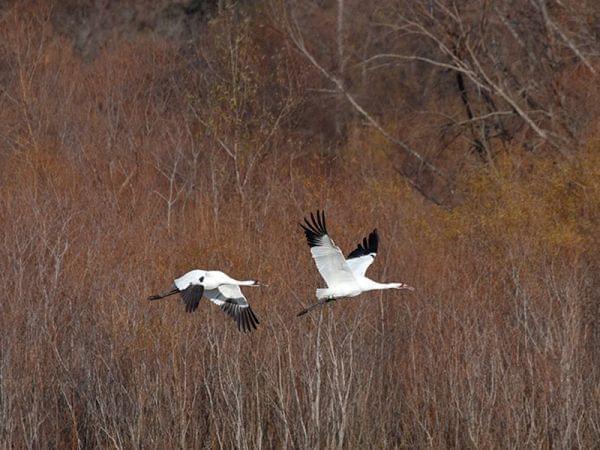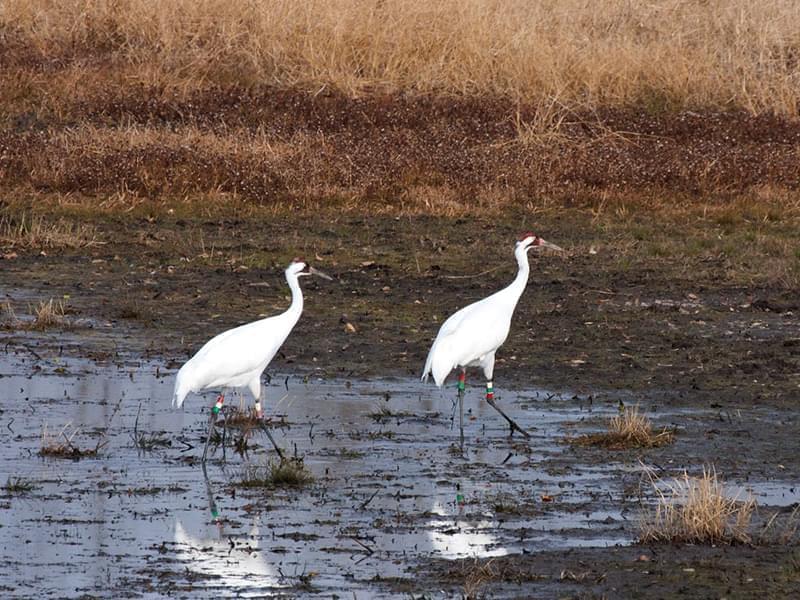Whooping cranes spotted during stop in Champaign County

Whooping Cranes in Flight Rob Kanter
Recently, my wife and I were out for an afternoon of birding at the Middle Fork River Forest Preserve in the northeast corner of Champaign County, when we came upon a pair of birds I’ll never forget. They were nearly five feet tall with long black legs and snowy white feathers, red caps, black masks and bright yellow eyes. Although I had never before seen them in person, I knew immediately they were whooping cranes.
Whooping cranes occur only in North America and they were apparently never very common. Their numbers plummeted through the nineteenth and twentieth centuries as a result of unregulated hunting and habitat destruction. At three points in the 1940s and 50s, the total population of whooping cranes dipped to 23 birds, with just 16 individuals in the only remaining wild flock at one time.
Since then, some of the most intensive, coordinated species recovery efforts ever mounted have brought whooping cranes back from the brink--very slowly, and with plenty of bumps in the road.
The conspicuous banding on the pair of whooping cranes my wife and I observed indicates they are the result of one of these efforts, a collaboration among state, federal and nonprofit agencies called the Whooping Crane Eastern Partnership. The purpose of the partnership is to establish a self-sustaining migratory population of whooping cranes in eastern North America.

Whooping Cranes at the Middle Fork Forest Preserve
This is a critical addition to the wild population in the west, which breeds in northern Alberta and spends the winter in Texas near the Gulf of Mexico. That’s because a single disaster, such as a hurricane, could kill them all at once.
Chicks destined for the eastern migratory flock are hatched from eggs produced by captive breeding pairs and raised according to careful protocols to ensure they grow up understanding themselves to be whooping cranes, not people.
During their first year, some of these chicks participate in Operation Migration (OM). They learn to fly behind an ultralight aircraft, which then “teaches” them to migrate from their summer home in Wisconsin, to a National Wildlife Refuge in Florida where they spend the winter. The female of the pair we saw is a graduate of this program.
Other chicks destined for the eastern flock are part of an experiment called Direct Autumn Release. Instead of learning to follow an ultralight, they’re released among wild cranes and learn the migration route from them. The male of the pair we saw came from this program.
The whooping cranes we saw formed a bond in the summer of 2010 and have been together since. They have nested and produced eggs, but have yet to succeed with a chick. Fortunately, whooping cranes can live into their mid twenties, so there is plenty of room to hope for them as a pair.
There is also room to hope for whooping cranes as a species. Roughly 400 of them currently live in the wild and another 200 are held at research and breeding facilities.
It’s natural to celebrate the recovery of whooping cranes as a conservation success, and certainly many smart, dedicated people deserve boatloads of credit for working to make it happen. But whooping cranes are among the most beautiful creatures that have ever lived. It’s a little more difficult to believe humans can muster the collective will to stop the ongoing destruction of so many other, less charismatic species around the globe.

